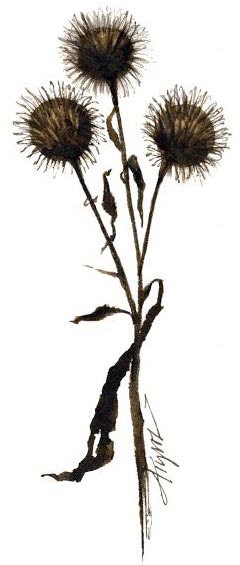
Hang off, thou cat, thou burr! vile thing, let loose,
Or I will shake thee from me like a serpent!
-William Shakespeare, A Midsummer Night’s Dream
The aroma of wood smoke lingers as you take your evening stroll. The sun has slipped behind the hills as the moon takes its watch at the other end of the valley. It’s the moment of twilight when solid figures are no longer discernible from shadows, and so you fail to notice the tiny hitchhiker lurking beside the path.
Upon your return, you reach down to untie your shoes and feel a painful pinch. After a blood-curdling “YOWCH!” you reach the light switch. Once your eyes adjust, you see the culprit – a spine-covered bur.
It’s no easy task getting to the roots of a burdock plant (anyone who’s ever tried to pull one out of the soil will know this pun is intended). Both burdocks (in the genus Arctium), and their look-alike cousins the cockleburs (in the genus Xanthium), belong to the aster family, a huge group that includes sunflowers and goldenrods. They are also both characterized by a tendency to prick fingers and ride through the laundry cycle on socks.
Burdocks, which are native to Europe, most likely arrived in America with the early settlers. (Sheep wool is a perfect hiding place for spiny stowaways.) Cockleburs, on the other hand, are native to North America, as well as other parts of the world.
What we commonly call burs are actually modified leaves (bracts), adapted to form prickly pouches that contain one-seeded fruits. The tendril-like spines of the bracts end in tiny, microscopic hooks. When an unsuspecting person or animal happens by, these hooks catch onto fur or clothing. By this means, burs can hitch rides far from their parent plants.
For autumn walkers, hunters, and especially dog owners, burs can be hard to love. But they’ve long been a source of food, medicine, and even human inspiration. Curious about how cockleburs had attached to his clothing and his dog’s fur, Swiss engineer George De Mestral investigated burs with a microscope and discovered tiny hooks at the end of the spikes. His research led to the invention of Velcro.
In most burdock species, the roots and leaves are edible. In Japan, the roots, called gobo, are boiled and eaten like a carrot. There are also stories of Native Americans boiling the roots in maple syrup to produce a kind of candy.
Burdock is also valued for medicinal uses. Derivatives of burdock leaves and roots have been used to treat skin ailments and immune deficiencies, and to flush toxins from the body. Traditional Roma healers reportedly use burdock as a prevention and treatment for rheumatism. It’s also a common ingredient used in witchcraft folklore.
Burdock also has romantic uses. At the risk of pricked fingertips, English children toss a bur on the back of an unsuspecting crush. If it sticks to his or her shirt, it was meant to be; if it falls off, well, keep on flinging.
My favorite folk use of the bur comes from Queensferry, Scotland. Every year, on the second Friday in August, the Burry Man makes his annual march around town. While traditions and tales vary, the Burry Man is said to symbolize regeneration or fertility; he’s also associated with warding off evil and bringing good luck.
To play the part of Burry Man, a brave Scotsman covers himself in flannel, including a knitted face mask, and then is decorated with thousands of burs. Assisted by attendants, he makes a day of hobbling to pubs and homes, where he’s offered whiskey (through a straw, of course).
The next time you find yourself unintentionally playing the role of Burry Man and are tempted to curse your prickly freeloaders, remember the many benefits of these plants. It may take a few minutes to remove burs from your clothing, but consider how much time you’ve saved over the years using Velcro.


Discussion *